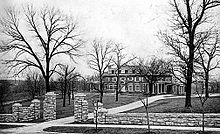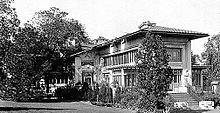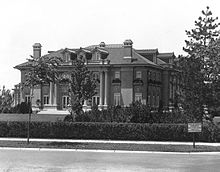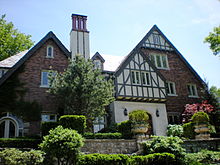- Country Club District
-
For the district in Edina, Minnesota, see Country Club District (Minneapolis).
 J. C. Nichols House in Sunset Hill, located on West 55th Street between Ward Parkway and State Line Road
J. C. Nichols House in Sunset Hill, located on West 55th Street between Ward Parkway and State Line Road
The Country Club District is the name of a group of neighborhoods comprising a historic upscale residential district in Kansas City, Missouri, and Johnson County, Kansas, USA, developed by noted real estate developer J.C. Nichols. The district was developed in stages between 1906 and 1950. Today it is home to approximately 60,000 people and includes such well-known Kansas City neighborhoods as Sunset Hill and Brookside in Missouri, Mission Hills, Fairway, and the oldest parts of Prairie Village in Kansas, making it the largest planned community built by a single developer in the United States. Ward Parkway, a wide, manicured boulevard, traverses the district running south from the Country Club Plaza, the first suburban shopping center in the United States.
Contents
History
J.C. Nichols began developing the district 1906 with a neighborhood he called Bismarck Place. As his development expanded to include Countryside, he began to develop a master plan which he dubbed the Country Club District because of its proximity to what was then the site of Kansas City Country Club, now Loose Park. Eventually, Nichols acquired a tract of land crossing from Missouri into Kansas, which now includes the neighborhood of Sunset Hill (in Missouri) and the city of Mission Hills (in Kansas). Nichols also built the nearby Country Club Plaza, which was the first shopping center in the United States designed to accommodate patrons arriving by automobile. Today, the Country Club District is the largest contiguous planned community built by a single developer in the United States.
Controversial restrictive covenants
 Bernard Corrigan House at the intersection of Ward Parkway and West 55th Street, designed by Louis Curtiss after plans by Frank Lloyd Wright
Bernard Corrigan House at the intersection of Ward Parkway and West 55th Street, designed by Louis Curtiss after plans by Frank Lloyd Wright
Nichols used restrictive covenants, or "deed restrictions", in each property in the district to control the use of the land. Most of the covenants pertain to the uses to which the property owner could put to his land, or contain setback and free space requirements.
A controversial aspect of the covenants in the district, however, was the use of racial restrictions that prohibited ownership and occupation by African Americans, Jews, and other ethnic minorities. The 1948 Supreme Court decision Shelley v. Kraemer made such restrictions unenforceable, and the Fair Housing Act of 1968 prohibited the future incorporation of such covenants. Nevertheless, restrictions continue to appear in the deeds to Country Club District properties. The restrictions require that a notice to amend be filed five years in advance of the deed restrictions renewal date, usually every twenty to twenty-five years, and that all homeowners must agree to the change with a notarized vote. This practical difficulty is the reason racial restrictions continue to appear throughout the district. At the same time, this practical difficulty has protected the other covenants from change, and thus has helped to preserve the essential character of the neighborhood and to resist encroachment by commercial developers.
While Nichols utilized the restrictive covenant model to bar non-whites from his neighborhoods, Nichols was not the first in Kansas City to engage in the practice. In fact, such practice had been in full force in Kansas City since the time Nichols was born in the 1880s. Moreover, although Nichols's covenants were discriminatory, Kansas City historian William S. Worley noted that Nichols was among the first of his contemporaries to abandon the practice of barring sale to Jews.
Today the Country Club District is still predominantly white, and still is home to Kansas City's wealthiest residents.
School desegregation and white flight
On the Missouri side, many residents formerly sent their children to Southwest High School, a public school in the Kansas City School District. At its peak in the mid-1960s, Southwest High School had more than 2,400 students, 20 percent of whose parents were Southwest alumni. After the end of racial segregation in schools under Brown v. Board of Education, however, Kansas City, Missouri, experienced considerable "white flight." By the 1997-1998 school year, Southwest's final year in existence, enrollment had dropped to below 500. Today, nearly all residents of the Missouri side of the Country Club District send their children to elite private schools, including the Pembroke Hill School, The Barstow School, Rockhurst High School, St. Teresa's Academy and Notre Dame de Sion.
Homes and residents
 Tom Pendergast's home along Ward Parkway
Tom Pendergast's home along Ward Parkway
The district includes many homes by or after plans of many noted architects, including Frank Lloyd Wright, McKim, Mead, and White, Louis Curtiss, and Mary Rockwell Hook. Several homes are listed on the National Register of Historic Places, or its subset, the National Register of Historic Homes.
Notable residents of the Country Club District have included:
- Mayor Harold Roe Bartle
- Mayor Richard L. Berkley
- H&R Block founder Richard Bloch
- Senator Kit Bond
- Major League Baseball Hall of Famer George Brett (baseball)
- author Evan S. Connell
- Hallmark Cards chairman Donald J. Hall, Sr.
- Hallmark Cards founder Joyce Hall
- composer John Kander
- businessman R. Crosby Kemper Jr.
- pharmaceutical magnate Ewing Kauffman and his wife Muriel Kauffman
- United States Senator Claire McCaskill
- UCLA and KU chancellor Franklin David Murphy
- political boss Tom Pendergast
- Ambassador Charles H. Price II
- columnist Calvin Trillin
- professional golfer Tom Watson
- Mayor Charles Wheeler.
Trivia
For two weeks in October 1977, renowned artist couple Christo and Jeanne-Claude wrapped Loose Park's 4.5 km of footpaths in 12,500 square meters of saffron-yellow colored shiny nylon fabric; the project cost the artists $130,000.
In 1970, members of the Students for a Democratic Society (SDS) were charged with pipe bombing the home of J.C. Nichols, among other places in Kansas City. Three SDS members were convicted. See United States District Court for the Western District of Missouri, Western Division (Kansas City), Criminal Case Files (1879- 1972), Case 23498.
Further reading
- Evan S. Connell, Mrs. Bridge (North Point Press, 1959) and Mr. Bridge (North Point Press, 1969).
- Novels set in the Country Club District between the 1920s to the 1940s, with frequent references to the district and the Country Club Plaza.
- Evan McKenzie, Privatopia: Homeowner Associations and the Rise of Residential Private Government (Yale University Press, 1996).
- Robert Pearson and Brad Pearson, The J. C. Nichols Chronicle: The Authorized Story of the Man and His Company, 1880–1994 (Lawrence, Kansas: University Press of Kansas).
- Sherry Lamb Shirmer, A City Divided: The Racial Landscape of Kansas City, 1900-1960.
- William S. Worley, J. C. Nichols and the Shaping of Kansas City: Innovation in Planned Residential Communities (Columbia, Missouri: University of Missouri Press, 1990).
See also
- Mr. and Mrs. Bridge
- Merchant-Ivory film based on Evan S. Connell's novels, filmed largely on location
- Quality Hill
- Kansas City neighborhood which was the predecessor to the Country Club District
- List of neighborhoods in Kansas City, Missouri
External links
- University of Missouri-Kansas City: "Ward Parkway: a Grand American Avenue"
- Original Map of the Country Club District -- produced by the J.C. Nichols Company early on in the development
- Planning for Permanence -- the speeches of J.C. Nichols
- Homes Associations of the Country Club District Home Page
- Umbrella organization to all homes associations in the Country Club District, covering 22,000 homes
- Community Builder: The Life & Legacy of J.C. Nichols
- A documentary about J.C. Nichols produced by PBS in 2006
- O High School, My High School!
- Essay by Gerald Shapiro appearing in the Colorado Review abouth Southwest High School, the Country Club District, and racial segregation in Kansas City, Missouri
The Kansas City Area Kansas City • The Metro Area • History • Economy • Neighborhoods • Architecture • Fountains • Barbecue • Jazz • Broadcast • Film • Education • SportsCategories:- Kansas City metropolitan area
- Neighborhoods in Kansas City, Missouri
- Populated places established in 1906
Wikimedia Foundation. 2010.


